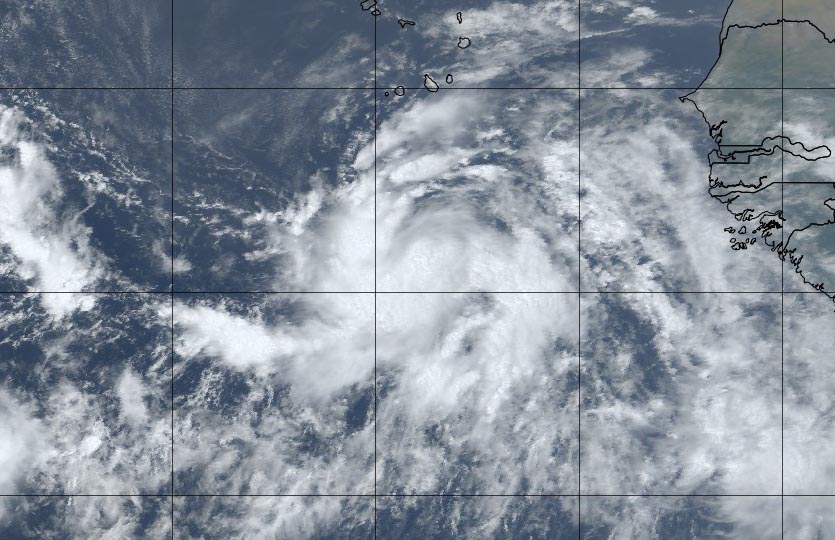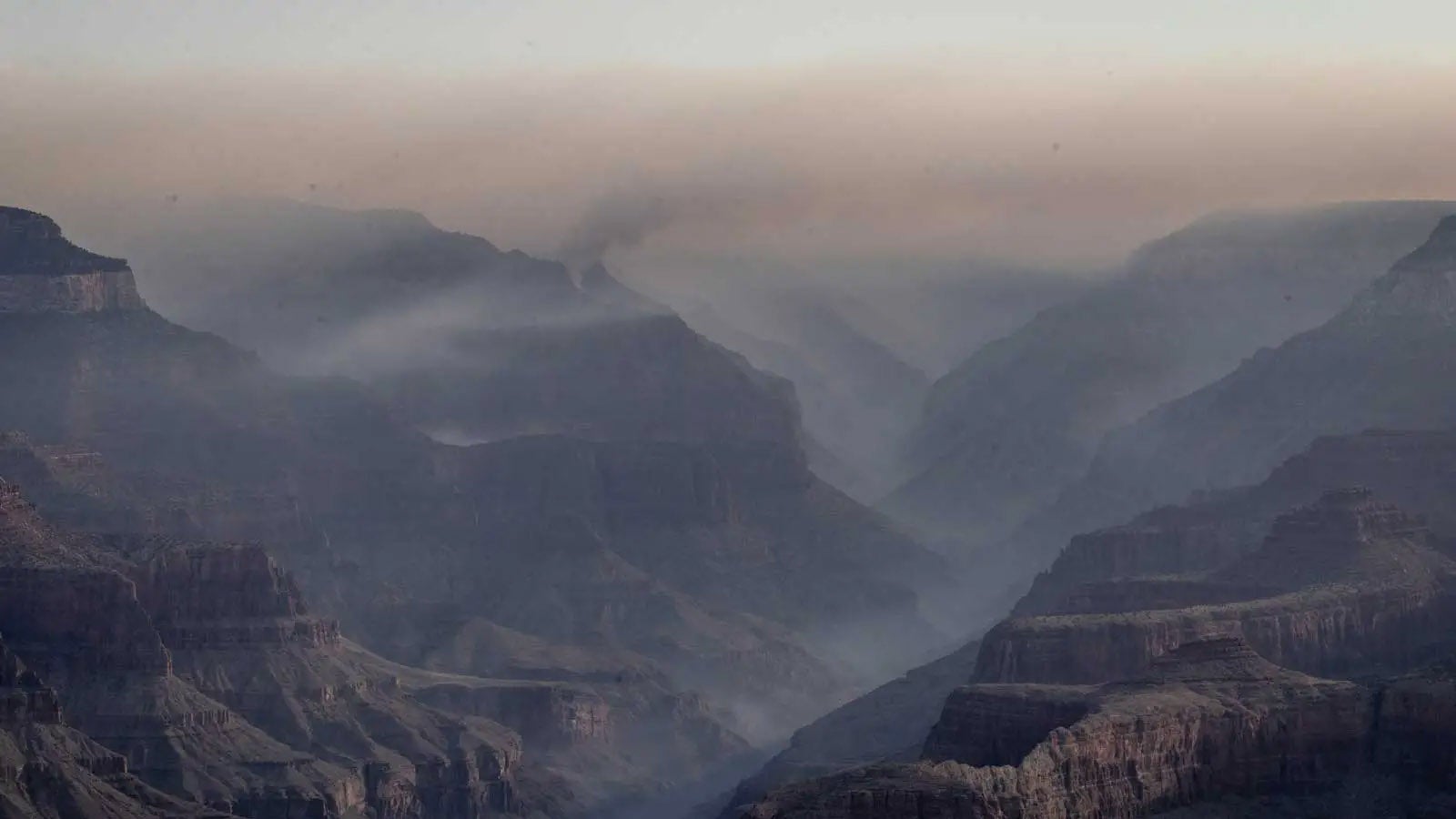| Above: Tropical Storm Karen at 11 am EDT September 23, 2019. At the time, Karen was struggling to stay alive, and had top winds of 40 mph. Image credit: NOAA/RAMMB. |
Tropical storm warnings are up for Puerto Rico and the U.S. and British Virgin Islands ahead of Tropical Storm Karen, which will be approaching the islands from the south on Tuesday.
The Hurricane Hunters found a highly disorganized Karen on Monday morning, with a broad center of circulation and virtually all the winds below tropical storm strength. Showers and thunderstorms (convection) had reformed near Karen’s low-level center by late morning after having been shunted well to the south overnight. Karen’s top winds were set at 40 mph in the 11 am EDT advisory from the National Hurricane Center, in anticipation that Karen will reconsolidate around the low-level center. “It is also possible that Karen could degenerate into an open wave, if it has not done so already,” NHC noted.
Northerly wind shear of 25 – 35 knots, due, in part, to upper-level outflow from Tropical Storm Jerry, will be Karen’s main nemesis over the next day or so. These upper winds are disrupting the circulation and injecting dry air into the otherwise moist environment surrounding Karen. Despite very warm sea surface temperatures (SSTs) of around 29°C (84°F) in the eastern Caribbean, Karen is too disorganized to intensify much before it reaches Puerto Rico and the Virgin Islands. Karen’s ill-defined center will most likely move across Puerto Rico on Tuesday, bringing periods of squally weather and up to 6” of localized rainfall to the island and the adjacent Virgin Islands.
***NEW VIDEO***#Karen brought serious flooding to Trinidad and Tobago on Sunday! Enough flooding to even lift cars and float them down the street! Karen will continue to move North towards Puerto Rico in the coming days. Stay tuned to see where #TropicalStormKaren goes. pic.twitter.com/Kyy1GzhVqN
— WeatherNation (@WeatherNation) September 23, 2019
The long-range outlook for Karen
The big question for later this week and beyond is how Karen will evolve as it moves north of Puerto Rico. Conditions will be much more supportive for development late this week, as a strong subtropical ridge will be developing to the north of Puerto Rico and Hispaniola. This will allow upper-level winds to diminish and wind shear to drop substantially, into the 10 - 20 knot range. These conditions should allow Karen to become a more organized system atop warm SSTs of 28-29°C (82-84°F), and Karen could be a hurricane by this weekend.
Karen will likely become trapped beneath the upper ridge late this week, when the storm’s northward trek will slow or stall. What happens at that point will depend in part on Tropical Storm Jerry. If Jerry moves slowly out to sea, it may leave behind enough of a break in the ridge to coax Karen on a recurving path as well. The more quickly Jerry moves away, though, the more likely it is that the upper ridge will strengthen behind it and push Karen westward, towards The Bahamas and U.S. East Coast.
#Karen's future beyond mid-week is almost impossible to figure out before we know what #Jerry will do. There is remarkable spread on where the storm will be on Wednesday evening, which will influence #Karen's steering
— Levi Cowan (@TropicalTidbits) September 23, 2019
EPS low locations valid Wednesday evening from @Weathernerds pic.twitter.com/jfwCcCnSHm
Two of our leading track models, the GFS and European, differed starkly on their long-term prognoses for Karen in their 0Z Monday ensemble output. All 21 of the GFS ensemble members kept Karen stalled or recurved the storm, whereas only about 10-20% of the European ensemble members recurved Karen, and more than 20% of the remaining members took Karen across Florida or Cuba more than a week from now. In their operational runs from 0Z Monday, the European model showed Karen speeding across the Florida Keys next Monday, the GFS had Karen moving across South Florida next Tuesday, and the UKMET depicted Karen more than 500 miles east of northern Florida, moving slowly westward, by next Monday.
It’s clearly way too soon to assign any firm probabilities to these divergent long-range outcomes. For now, it’s enough to know that we may need to keep an eye on Karen well beyond this week. (In case you’re wondering about the origin of the already-omnipresent Karen memes, here’s a primer from TIME.)
 |
| Figure 2. Tropical Storm Jerry at 9:50 am EDT September 23, 2019. At the time, Jerry had top winds of 65 mph. Image credit: NOAA/RAMMB. |
Tropical Storm Jerry headed towards Bermuda
A Tropical Storm Warning is up for Bermuda as Tropical Storm Jerry heads north-northwest at 7 mph towards the island. At 11 am EDT Monday, Jerry was located 345 miles south-southwest of Bermuda, with top winds of 65 mph, headed north-northwest at 7 mph. Satellite loops late Monday morning showed that Jerry was struggling with very high wind shear near 35 knots, which had exposed the low-level circulation center to view and limited heavy thunderstorm activity to the northeast side of the center. With wind shear expected to be moderate to high over the next five days, ranging from 15 to 35 knots, Jerry is likely to remain below Category 1 hurricane strength.
Jerry is expected to take a turn to the north and then northeast towards Bermuda Monday night through Tuesday. On this track, Jerry is likely to pass less than 150 miles to the northwest of Bermuda on Tuesday afternoon through Wednesday morning. During that period, tropical storm-force winds are predicted to extend out about 150 miles to the northeast of Jerry’s center, giving Bermuda at least a 50/50 chance of experiencing tropical storm-force winds. The 11 am EDT Monday wind probability forecast from NHC gave Bermuda a 64% chance of experiencing tropical storm-force winds. Jerry will bring heavy rains to Bermuda beginning on Tuesday morning, with NHC calling for storm-total rainfall amounts of 1 – 3” on the island, through Wednesday.
Jerry will be the second named storm to affect Bermuda in the past week; on September 18, Hurricane Humberto passed just to the northwest of the island as a Category 3 hurricane with 120 mph winds. Humberto’s powerful right-front eyewall passed over Bermuda, bringing it sustained hurricane-force winds and knocking out power to about 80% of the island. The Bermuda airport recorded sustained winds of 82 mph, gusting to 116 mph, at the height of the storm, and the Bermuda Maritime Operations Centre (at an elevated location) recorded a wind gust of 144 mph. No injuries or major damage were reported in Bermuda, and the Bermuda Government announced that all government offices and schools would be open on Monday, September 23.
 |
| Figure 3. Tropical Storm Lorenzo off the coast of Africa at 10:25 am EDT September 23, 2019. At the time, Lorenzo had top winds of 40 mph. Image credit: tropicaltidbits.com. |
Tropical Storm Lorenzo forms off the coast of Africa
Tropical Storm Lorenzo formed on Monday morning off the coast of Africa, about 300 miles south of the Cabo Verde Islands. Lorenzo’s formation gives the Atlantic 12 named storms, 4 hurricanes, 2 intense hurricanes, and an ACE index of 82 so far in 2019. An average season typically has 8 named storms, 4 hurricanes, 2 intense hurricanes, and an ACE index of 73 by September 23.
Satellite images late Monday morning showed that Lorenzo had an impressive circulation with plenty of heavy thunderstorms that were quickly growing more organized. Lorenzo is expected to pass at least 300 miles to the south of the Cabo Verde Islands Monday though Tuesday, and southern portions of the islands may see some heavy rain showers from Lorenzo’s outer spiral bands. The latest model runs predict that Lorenzo will not trouble any other land areas over the coming week, which is fortunate, since conditions appear ideal for Lorenzo to intensify into a hurricane, possibly a major hurricane, by late this week.
The Atlantic has had 5 named storm formations since September 14: #Humberto, #Imelda, #Jerry, #Karen, and #Lorenzo. This is the most Atlantic named storm formations on record between September 14-23, breaking the old record of 4 set in 1984, 1998, and 2002. pic.twitter.com/sjAPLZkBGv
— Philip Klotzbach (@philklotzbach) September 23, 2019
Cyclone Hikaa heading for Oman
Hovering close to hurricane strength, Cyclone Hikaa is on a course through the Arabian Sea that will bring it to the coast of Oman on Wednesday local time. Hikaa is quite well organized for a cyclone in this part of the world. SSTs of 26-27°C (79-81°F) along Hikaa’s path are 1-2°C (1.8-3.6°F) above average, supporting development. Wind shear is moderate (around 15 knots), but with the surrounding atmosphere fairly dry (midlevel relative humidity around 40%), Hikaa's intensification may halt before it reaches Oman, unless it can continue to wall off a moist central core.
Cyclone #Hikaa Is likely at hurricane strength now, with a pretty well defined eye and prominent spiral bands. It will continue to intensify as it heads towards #Oman. pic.twitter.com/zLnYBl8Efs
— Alex Lubbers (@AlexLubbers2) September 23, 2019
Oman typically gets a tropical cyclone landfall once every year or two, based on reliable statistics going back to the 1970s. Nearly all of these cyclones arrive well below hurricane strength. Cyclone Gonu, the most destructive tropical cyclone on record to strike Oman, reached Category 4 strength in the Arabian Sea and came ashore as a Category 1 storm on June 6, 2007. Gonu caused $4 billion in damage (2007 USD) and took 50 lives. The strongest known landfall in Oman was from Cyclone Mekunu, which made landfall as a borderline Cat 2/3 storm in far southern Oman on May 25, 2018. Mekunu left $1.5 billion in damage (2018 USD) in Yemen, Oman, and Saudi Arabia, and caused 31 deaths.
Hikaa is threatening Oman at a slightly unusual time of year. Most of the nation’s tropical cyclones arrive between May and early July, or between October and December.
Bob Henson co-wrote this post.




